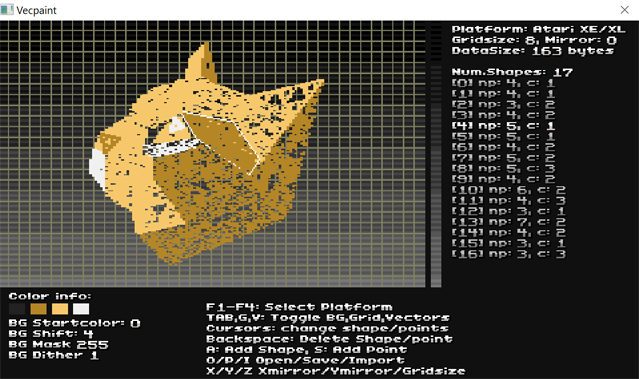Introduction:
The third lovebyte party was a massive succes. New compos, new release records and the Woz making an appearance!
Since I was involved with the organisation of the party, I tried to steer away from participating in the major compos and focus more on compos that weren't held at any other party.
Dozer (256 Bytes Executable Graphics, Atari XE/XL):
This production is a tribute to our loving cat Dozer, who wasn't doing well at the time of creating this production. He just had an operation and needed follow up treatment to recover.
The tooling for this production started in 2022 after Brave New World. I started by working on a (hopefully) somewhat multi-platform vector painting tool that would be able to export polygons to sensible formats on 8-bit and 16-bit machines.
Some of these machines (like for example Atari ST) had a way of drawing (very slow) polygons out of the box, whilst other machines might offer something like drawing lines first and then having a slow (basic) floodfill of sorts.

Back in 2020 Ilmenit had used a technique called chaos game to draw the galaxy bit in his intro Galactic Bearing. This is an extremely easy to implement technique which allows you to draw 'more or less fractal-filled' convex polygons. Simply put it works as follows:
1) Start at any point in the polygon x,y.
2) Selecting a random points in the polygon px,py.
3) Jump half way to that point: x=(x+px)/2 y=(y+py)/2
4) Jump to two until your iteration count is zero.
The tool exports raw polygon data:
* A a single byte per polygon containing both the colorindex and the number of points.
* A set of x,y pairs per polygon vertex.
The intro had about 160-180 bytes of data, with the rest of the sizebudget going to the setup, draw routine and (very minimal) raster routine. Blossom helped a lot steering the visual look'n feel where just small tweaks to the point positions would have a huge impact on the overall look.
So what about the star of this intro?
I'm happy to report that after a small year of treatment that our cat Dozer is still enjoying his time with us and we are thankful for every day we're allowed to spend with him.
Isometrica (32 Bytes, DOS):
My contribution to this years highend 32 byte intro compo came in the form of Isometrica, which as the name would suggest uses an isometric perspective, which was achieved by only using the upper part of the rrrola constant (ah = 0xcc) and leaving the bottom-part as-is.
The initial version started the year before during a week-long holiday in the german schwarzwalt. Initially the idea was to see if I could get some kind of 'progression over time' happening in 32 bytes, by using a 16-bit register as a counter and using the upper part to mask for different (isometric) tile patterns.
Once this was working (in the grayscales) i was thinking i could sample pixelvalues elsewhere in the screenbuffer to (hopefully) get some interesting movement going (because of the shearing). After much tweaking this turned out even better than i hoped and was able to get something looking more like blended parallax layers, without having to do the actual blending of colorvalues.
I'm really happy how this one turned out in terms of having progression in a 32 byte entry as well as the parallax layers.
Nightwatch (256 Bytes Executable Graphics, TIC-80):
This executable graphics entry was done by Blossom as a sequel to Snowgazer. As I didn't work on this production myself I don't know the precise technical details other than the layered trees and snow were the first things to get done, after which the cat sillouette, moon, stars and raster background were added.
I particulary like the depth in the image as well as the nice portrait type framing that was done.
Frantic (16 Bytes, Atari XE/XL):
This intro uses the Atari Player-Missile sprites in combination with the VCOUNT scanline register to get a xor-walk pattern whilst also using that same value to set as the player-missile graphics.
I had this working in 16 bytes over the default cyan Atari 8bit background, which was sub-optimal. Thanks to g0blinish for suggesting to use $22E as the start adress, which since the code was small enough would mean a write to disable video.
Here is the sourcecode:
*=$22E
frameloop:
lda $D40B ; VCOUNT
eor 20 ; UPDATECOUNTER
sta $d00d ; GRAFP0
sta $d000 ; HPOSP0
sta $d012 ; COLPM0
bvc frameloop
8 Byte Showcase (8 Bytes, DOS):
I always have fun with tinkering with new 8 byte intros and this year was no exception:
Luck&Love
This was one of the variants of the 'diagonal scrolling pattern' kind that i always kind of liked for its consistency and the inclusion of hearts, so when Blossom came up with the title for this one it sort of made the package complete.
les ax,[si]
frameloop:
aaa
stosb
scasw
xlatb
jmp frameloop
Navig8r
Another textmode prod with diagonally scrolling squares. Title is a slight nod to Flight of the Navigator.
Sourcecode:
les ax,[si]
frameloop:
stosw
lodsb
adc si,ax
jmp frameloop
Conclusion:
Lovebyte 2023 turned out great and i was happy with the prods that i submitted.
For more information about all the Lovebyte 2023 releases, you can find them at demozoo
- Enjoy!